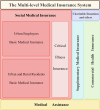Analysis the status and spatio-temporal characteristics of the synergistic development of China's multi-level medical insurance system
- PMID: 40263485
- PMCID: PMC12015542
- DOI: 10.1038/s41598-025-96922-7
Analysis the status and spatio-temporal characteristics of the synergistic development of China's multi-level medical insurance system
Abstract
Examined the synergistic development and spatio-temporal evolution of China's multi-level medical insurance system (MMIS) on a macroscopic level. We assess the comprehensive development of the MMIS across China's 31 provinces from 2011 to 2020 by constructing a comprehensive indicators evaluation model. Subsequently, a coupling coordination index (CCI) model is employed to provide precise insights into the coupling coordination effects among various medical insurance schemes comprising MMIS. Lastly, spatial autocorrelation analysis is conducted to evaluate both the global and local spatio-temporal evolutionary characteristics of MMIS. The CCI of MMIS at the national average level exhibited a fluctuating upward trend, progressing from the moderate disorder recession degree (0.287) in 2011 to the well-coordinated degree (0.887) in 2020. However, the majority of provinces (83.87%) still lingered within the realm of barely coordinated degree ([0.500-0.600]). Specifically, the CCI within the eastern coastal region surpassed that of the western and central regions, with the central region showing the most pronounced increase in CCI. Over the past decade, MMIS demonstrated significant spatial agglomeration, as evidenced by the global Moran's I ranging from [0.1668-0.3037]. Furthermore, findings from local spatial autocorrelation analysis suggest a gradual attenuation in the spatial clustering disparity of CCI across various provinces. Government ought to focus on the spatio-temporal evolution patterns of MMIS, and strengthen cooperation between the government and market in health governance, while utilizing information technology and data sharing to improve the overall quality of medical insurance benefits.
Keywords: Coupling coordination index; Health financing; Health governance; Multi-level medical insurance system; Spatio-temporal evolution characteristics; Universal health coverage.
© 2025. The Author(s).
Conflict of interest statement
Declarations. Competing interests: The authors declare no competing interests. Availability of data and materials: The data that support the findings of this study are openly available in China Statistical Yearbook, China Health Statistical Yearbook, China Medical Security Statistical Yearbook, China Civil Affairs Statistical Yearbook and https://www.cbirc.gov.cn/cn/view/pages/tongjishuju/tongjishuju.html .
Figures




References
-
- Yip, W. et al. Universal health coverage in China part 2: Addressing challenges and recommendations. The Lancet. Public Health8(12), e1035–e1042. 10.1016/S2468-2667(23)00255-4 (2023). - PubMed
-
- Meng, Q., Fang, H., Liu, X., Yuan, B. & Xu, J. Consolidating the social health insurance schemes in China: Towards an equitable and efficient health system. Lancet386(10002), 1484–1492. 10.1016/S0140-6736(15)00342-6 (2015). - PubMed
MeSH terms
Grants and funding
LinkOut - more resources
Miscellaneous
